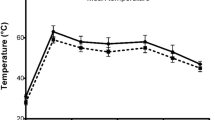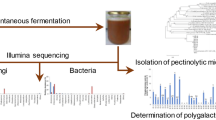Abstract
Being insoluble in the oxidize form, indigo dye must be solubilized by reduction for it to penetrate textile. One of the procedures is the reduction by natural bacterial fermentation. Sukumo, composted leaves of Polygonum tinctorium, is a natural source of indigo in Japan. Although sukumo has an intrinsic bacterial seed, the onset of indigo reduction with this material may vary greatly. Certain additives improve indigo fermentation. Here, we studied the effects of Indigofera tinctoria leaf powder (LP) on the initiation of indigo reduction, bacterial community, redox potential (ORP), and dyeing intensity in the initial stages and in aged fermentation fluids prepared with sukumo. I. tinctoria LP markedly decreased ORP at day 1 and stabilised it during early fermentation. These effects could be explained by the phytochemicals present in I. tinctoria LP that act as oxygen scavengers and electron mediators. Using next generation sequencing results, we observed differences in the bacterial community in sukumo fermentation treated with I. tinctoria LP, which was not influenced by the bacterial community in I. tinctoria LP per se. The concomitant decrease in Bacillaceae and increase in Proteinivoraceae at the onset of fermentation, increase in the ratio of facultative to obligate anaerobes (F/O ratio), or the total abundance of facultative anaerobes (F) or obligate anaerobes (O) (designated F + O) are vital for the initiation and maintenance of indigo reduction. Hence, I. tinctoria LP improved early indigo reduction by decreasing the ORP and hasten the appropriate transitions in the bacterial community in sukumo fermentation.





Similar content being viewed by others
References
Aino K, Narihiro T, Minamida K, Kamagata Y, Yoshimune K, Yumoto I (2010) Bacterial community characterization and dynamics of indigo fermentation. FEMS Microbiol Ecol 74:174–183
Aino K, Hirota K, Okamoto T, Tu Z, Matsuyama H, Yumoto I (2018) Microbial communities associated with indigo fermentation that thrive in anaerobic alkaline environments. Front Microbiol 9:1–16
Boltyanskaya YV, Kevbrin VV (2016) Trophic interactions of proteolytic bacteria Proteinivorax tanatarense in an alkaliphilc microbial community. Microbiology 85:481–487
Bolyen E, Rideout JR, Dillon MR et al (2019) Reproducible, interactive, scalable and extensible microbiome data science using QIIME 2. Nat Biotechnol 37:852–857
Callahan BJ (2016) DADA2: High resolution sample inference from Illumina amplicon data. Nat Methods 13:581–583
Cardon D (2007) Natural dyes: sources, tradition, technology and science. Archetype Publications Ltd, London
Chavan RB (2015) Indigo dye and reduction techniques. In: Roshan P (ed) Denim. Cambridge: Woodhead Publishing Ltd, pp. 37–67
Clark RJH, Cooksey CJ, Daniel MAM, Withnall R (1993) Indigo, woad, and Tyrian Purple: important vat from antiquity to the present. Endeavour 17:191–199
Dellai A, Dridi D, Lemorvan V, Robert J, Cherif A, Mosrati R, Mansour HB (2013) Decolorization does not always mean detoxification: case study of a newly isolated Pseudomonas peli for decolorization of textile wastewater. Environ Sci Pollut Res 20:5790–5796
Douglas GM, Maffei VJ, Zaneveld J, Yurgel SN, Brown JR, Taylor CM, Huttenhower C, Langille MGI (2020) PICRUSt2 for prediction of metagenome functions. Nat Biotechnol 38:685–688
Głowacki ED, Voss G, Leonat L, Irimia-Vladu M, Bauer S, Sariciftci NS (2012) Indigo and tyrian purple e from ancient natural dyes to modern organic semiconductors. Isr J Chem 52:540e551
Hirota K, Aino K, Nodasaka Y, Morita N, Yumoto I (2013a) Amphibacillus indicireducens sp. nov., an alkaliphile that reduces an indigo dye. Int J Syst Evol Microbiol 63:464–469
Hirota K, Aino K, Yumoto I (2013b) Amphibacillus iburiensis sp. nov., an alkaliphile that reduces an indigo dye. Int J Syst Evol Microbiol 63:4303–4308
Hirota K, Okamoto T, Matsuyama H, Yumoto I (2016) Polygonibacillus indicireducens gen nov., sp. nov., an indigo-reducing and obligate alkaliphile isolated from indigo fermentation liquor for dyeing. Int J Syst Evol Microbiol 66:4650–4656
Hsu TM, Welner DH, Russ ZN, Cervantes B, Prathuri RL, Adams PD, Dueber JE (2018) Employing a biochemical protecting group for a sustainable indigo dyeing strategy. Nat Chem Biol 14:256–261
Light SH, Su L, Rivera-Lugo R, Cornejo JA, Louie A, Iavarone AT, Ajo-Franklin CM, Portnoy DA (2018) A flavin-based extracellular electron transfer mechanism in diverse Gram-positive bacteria. Nature 562:140–146
Nakagawa K, Takeuchi M, Kikuchi M, Kiyofuji S, Kugo M, Sakamoto T, Kano K, Ogawa J, Sakuradani E (2021) Mechanistic insights into indigo reduction in indigo fermentation: a voltametric study. Electrochemistry 89:25–30
Nakajima K, Hirota K, Nodasaka Y, Yumoto I (2005) Alkalibacterium iburiense sp. nov., an obligate alkaliphile that reduces an indigo dye. Int J Syst Evol Microbiol 55:1525–1530
Nicholson SK, John P (2005) The mechanism of bacterial. Appl Microbial Biotechnol 68:117–123
Nishita M, Hirota K, Matsuyama H, Yumoto I (2017) Development of media to accelerate the isolation of indigo-reducing bacteria, which are difficult to isolate using conventional media. World J Microbiol Biotechnol 33:133
Okamoto T, Aino K, Narihiro T, Matsuyama H, Yumoto I (2017) Analysis of microbiota involved in the aged natural fermentation of indigo. World J Microbiol Biotechnol 33:70
Park S, Ryu J-Y, Seo J, Hur H-G (2012) Isolation and characterization of alkaliphilic and thermotolerant bacteria that reduce insoluble indigo to soluble leuco-indigo from indigo dye vat. J Korean Soc Appl Biol Chem 55:83–88
Pham TH, Boon N, Aelterman P, Clauwaert P, De Schamphelaire L, Vanhaecke L, De Maeyer K, Hofte M, Verstraete W, Rabaey K (2008) Metabolites produced by Pseudomonas sp. enable a gram-positive bacterium to achieve extracellular electron transfer. Appl Microbiol Biot 77:1119–1129
Pruesse E, Quast C, Knittel K, Fuchs BM, Ludwig W, Peplies J, Glöckner FO (2007) SILVA: a comprehensive online resource for quality checked and aligned ribosomal RNA sequence data compatible with ARB. Nucleic Acids Res 35:7188–7196
Quast C, Pruesse E, Yilmaz P, Gerken J, Schweer T, Yarza P, Peplies J, Glöckner FO (2013) The SILVA ribosomal RNA gene database project: improved data processing and web-based tools. Nucleic Acids Res 41:D590–D596
Samanta AK, Agarwal P (2009) Application of natural dyes on textiles. Indian J Fiber Text Res 34:384–399
Sharma V, Singh R, Sharma S (2016) Comparative phytochemical investigation with TLC profiling of Indigofera tinctoria Linn. Natl Acad Sci Lett 39:337–334
Srinivasan S, Wankhar W, Rathinasamy S et al (2016) Free radical scavenging potential and HPTLC analysis of Indigofera tinctorialinn (Fabaceae). J Pharm Anal 6:125–131
Tu Z, Lopes HFS, Hirota K, Yumoto I (2019a) Analysis of the microbiota involved in the early changes associated with indigo reduction in the natural fermentation of indigo. World J Microbiol Biotechnol 35:123
Tu Z, Lopes HFS, Igarashi K, Yumoto I (2019b) Characterization of the microbiota in long- and short-term natural indigo fermentation. J Ind Microbiol Biotechnol 46:1657–1667
Vázquez-Baeza Y, Pirrung M, Gonzalez A, Knight R (2013) EMPeror: a tool for visualizing high-throughput microbial community data. GigaScience 2:16
Verbarg S, Rheims H, Emus S, Frühling A, Kroppenstedt RM, Stackebrandt E, Schumann P (2004) Erysipelothrix inopinata sp. nov., isolated in the course of sterile filtration of vegetable peptone broth, and description of Erysipelotrichaceae fam. nov. Int J Syst Evol Microbiol 54:221–225
Yi C, Tan X, Bie B, Ma H, Yi H (2020) Practical and environmental-friendly indirect electrochemical reduction of indigo and dyeing. Sci Rep 10:4927
You LX, Liu LD, Xiao Y, Dai YF, Chen BL, Jiang YX, Zhao F (2018) Flavins mediate extracellular electron transfer in Gram-positive Bacillus megaterium strain LLD-1. Bioelectrochemistry 119:196–202
Yumoto I, Hirota K, Nodasaka Y, Yokota Y, Hoshino T, Nakajima K (2004) Alkalibacterium psychrotolerans sp. nov., a psychrotolerant obligate alkaliphile that reduces an indigo dye. Int J Syst Evol Microbiol 54:2379–2383
Yumoto I, Hirota K, Nodasaka Y, Tokiwa Y, Nakajima K (2008) Alkalibacterium indicireducens sp. nov., an obligate alkaliphile that reduces indigo dye. Int J Syst Evol Microbiol 58:901–905
Zhang L, Wang L, Cunningham AB, Shi Y, Wang Y (2019) Island blues: indigenous knowledge of indigo-yielding plant species used by Hainan Miao and Li dyers on Hainan Island. China. J Ethnobiol Ethnomed 15:31
Acknowledgements
This work was supported by the Institute for Fermentation, Osaka (IFO) (No. G-2020-3-035). We thank Editage (www.editage.com) for English language editing.
Funding
This work received no financial support that could have influenced its outcome.
Author information
Authors and Affiliations
Contributions
HFSL, HS, and IY. conceived and designed the experiments. HFSL, ZT and HF performed the experiments. HFSL, ZT, HF and IY analysed the data. HFSL and IY wrote the manuscript.
Corresponding author
Ethics declarations
Conflict of interest
The authors declare that there is no conflict of interest.
Additional information
Publisher’s Note
Springer Nature remains neutral with regard to jurisdictional claims in published maps and institutional affiliations.
Supplementary Information
Below is the link to the electronic supplementary material.
Rights and permissions
About this article
Cite this article
de Fátima Silva Lopes, H., Tu, Z., Sumi, H. et al. Indigofera tinctoria leaf powder as a promising additive to improve indigo fermentation prepared with sukumo (composted Polygonum tinctorium leaves). World J Microbiol Biotechnol 37, 179 (2021). https://doi.org/10.1007/s11274-021-03142-y
Received:
Accepted:
Published:
DOI: https://doi.org/10.1007/s11274-021-03142-y




